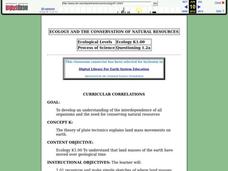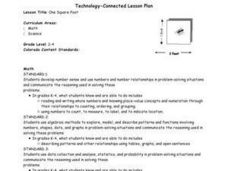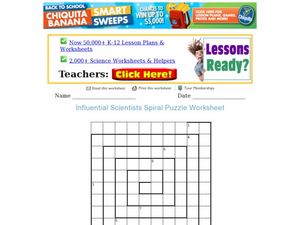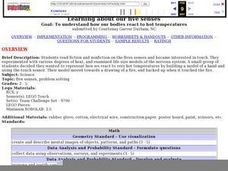Curated OER
Hey, Look Me Over!
Students make observations about mealworms using hand lenses, rulers, and cotton swabs. Students complete their own mealworm observation chart, then they share their observations with the class. This is one station out of five in an...
Curated OER
Oxygen
Students explore oxygen and its physical and chemical propeties. In this investigative lesson students complete several experiments using oxygen.
Curated OER
Design Project: Simple component curve-tracer circuit
In this circuit worksheet students complete a series of short answer questions on using a tracer circuit. There are answers with this worksheet.
Curated OER
Electrifying the World
Students explore the fundamental concepts of electricity. They examine different circuit diagrams to study how electricity flows. They finish by creating their own simple circuit.
Curated OER
Drifting Continents
Students, through teacher-led demonstration, explore the idea of continental drift. They complete a worksheet involving the calculation of continental drift over time.
Curated OER
Fungus
Students study fungus, its reproduction and uses. In this eukaryote instructional activity students complete several fungal experiments.
Curated OER
Pet Overpopulation
Students identify the needs of animals. In this animal welfare lesson, students read the article "If This Cat Could Wish" and identify the needs of animals. Students color in a coloring sheet of a cat.
Curated OER
Animals Vocabulary Maze
In this animal vocabulary activity, students read the clue and answer it with an animal vocabulary word and then find the word in the maze. Students complete 14 questions.
Curated OER
How Does a Green Plant Grow?
Students examine how a seed grows, and design an experiment to explore this concept. They make predictions, conduct the experiment, record the results, and interpret the results.
Curated OER
Ecology And the Conservation of Natural Resources
Students study Alfred Wegener's theory of continental drift and how the continents were connected in one large land mass called Pangaea. They examine plate tectonics and the theory that the earth's surface is composed of large moving...
Curated OER
Looking At Leaves
Learners investigate the different leaves of Wisconsin. They gather samples of leaves in order to compare to the samples taken from Puerto Rico. They make observations and collect data recording the size, shape, and texture of the...
Curated OER
Bivalve or Univalve (Clam or Snail)?
Fourth graders explore the meaning of the prefixes "bi" and "uni." In groups, 4th graders observe pictures of shells and handle real shells. Students create a chart to classify each shell as a bivalve or univalve. They identify the...
Curated OER
Spiders Crossword Puzzle
In this spiders crossword puzzle worksheet, students use the 10 clues and to help them correctly complete the spider-themed word puzzle.
Curated OER
Current Thinking About Magnets
Students construct their own magnet and wire device. In this inquiry instructional activity, students investigate the factors affecting the strength of magnetic forces. They manipulate different variable to determine their effect.
Curated OER
CREATE A CAVE
Students investigate the concept of caves by conducting an experiment. The lesson contains background information for the teacher. They collect data while making observations and write a review of the concept once the experiment is...
Curated OER
Children Just Like Me: Celebrations!
Students read literature that is multicultural in order to investigate the types of celebrations that people have in relation to holidays around the world. They can link up with different celebrations looking for similarities to how the...
Curated OER
Macroinvertebrate Mix and Match
Students are introduced to macroinvertebrates (primarily insects), the major segments of aquatic insects (the head, thorax and abdomen) and also differentiate between larval, nymph and adult stages. They investigate the head, thorax and...
Curated OER
One Square Foot
Students identify, describe, count, tally, and graph life found in one square foot of land.
Curated OER
Influential Scientists Spiral Puzzle
In this influential scientists worksheet, learners use 8 clues given at the bottom of the page to complete a word puzzle. Worksheet contains links to additional activities.
Curated OER
Rainforest Vocabulary
In this vocabulary worksheet, students match vocabulary words on the left with definitions on the right. Worksheet is labeled as a quiz, but may be used for practice/review.
Curated OER
The Truth About Bats
Students read information about bats in an encyclopedia. They discuss the different myths associated with the animal. They answer questions about the reading passage to end the lesson plan.
Curated OER
Biotic Factors
Students identify individual organism, a species, and a population within the study community. They identify biotic factors at the site and attempt to characterize the site's species diversity.
Curated OER
Learning About Our Five Senses
Students study the sense of touch and various degrees of heat. They design a model that displays how the human hand reacts to heat using a touch sensor.
Curated OER
Making Community Measurements: Which Plant Part?
Students identify a plant in a given community and make a variety of measurements. They determine how a plant meets its basic needs. In addition to identifying plant parts, they observe seasonal change and compare plants within a community.
Other popular searches
- K 2 Life Science Growth
- K 2 Life Science Living
- K 2 Life Science Insects
- K 2 Life Science Salamander
- K 2 Life Science Hibernation
- K 2 Life Science Adaptation
- K 2 Life Science Cells
- K 2 Life Science Nonliving
- K 2 Life Science Wind

























